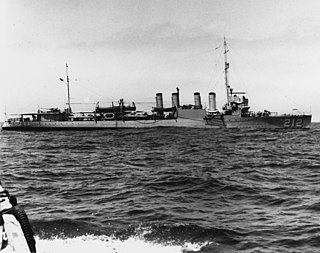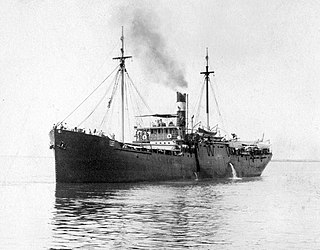
The United States Asiatic Fleet was a fleet of the United States Navy during much of the first half of the 20th century. Before World War II, the fleet patrolled the Philippine Islands. Much of the fleet was destroyed by the Japanese by February 1942, after which it was dissolved, and the remnants incorporated into the naval component of the South West Pacific Area command, which eventually became the Seventh Fleet.

The second USS Bainbridge was the first destroyer, also called "Torpedo-boat destroyers", in the United States Navy and the lead ship of the Bainbridge-class. She was named for William Bainbridge. Bainbridge was commissioned 12 February 1903. She served in the Asiatic Fleet before World War I and served in patrol and convoy duty during the war. She was decommissioned 3 July 1919.

USS Helena (PG-9) was a Wilmington-class gunboat of the United States Navy. She participated in the Spanish–American War, and served in the Far East for many years. The (PG-9) was the first of five Navy vessels named after the capital city of Montana.

USS Smith Thompson (DD-212) was a Clemson-class destroyer in service with the United States Navy from 1919 to 1936. She was intentionally sunk following a collision with USS Whipple (DD-217), in July 1936.

USS Pampanga (PG-39) was a schooner-rigged iron gunboat in the United States Navy during the Philippine–American War. She retained her Spanish name.

USS Stewart (DD-224) was a Clemson-class destroyer in the United States Navy during World War II. She was the second ship named for Rear Admiral Charles Stewart. Scuttled in port at Surabaya, Java, she was later raised by the Japanese and commissioned as Patrol Boat No. 102. She came back under American control in 1945 after the occupation of Japan.
The first USS Mariveles was a gunboat in the United States Navy during the Spanish–American War.

The first USS Annapolis (PG-10/IX-1) was a gunboat in the United States Navy. She was named for Annapolis, Maryland.

The second USS Monterey was the sole Monterey-class monitor. Laid down by Union Iron Works, San Francisco, California, 20 December 1889, she was launched 28 April 1891, sponsored by Miss Kate C. Gunn. She was commissioned 13 February 1893.

USS Isabel (SP-521), later PY-10, was a yacht in commission in the United States Navy as a destroyer from 1917 to 1920 and as a patrol yacht from 1921 to 1946.

USS Wilmington (PG-8) was the lead ship in a class of two United States Navy gunboats. She was laid down on 8 October 1894 at Newport News, Virginia, by the Newport News Shipbuilding Company; launched on 19 October 1895; sponsored by Mrs. Anne B. Gray; and commissioned on 13 May 1897.

The first USS Oahu (PR-6), a Yangtze River gunboat, was laid down by Kiangnan Dock and Engineering Works, Shanghai, China, 18 December 1926; launched as PG–46 on 26 November 1927; sponsored by Mrs. Bryson Bruce, wife of Comdr. Bruce; and commissioned 22 October 1928, Lt. Comdr. A. C. Thomas in command.

USS Elcano (PG-38) was a gunboat that the United States Navy captured from the Spanish Navy during the Spanish–American War. She was officially commissioned in the U.S. Navy in 1902. She served for many years in the Yangtze Patrol where she saw action against pirates and warlords. She served until decommissioning in 1928, when she was sunk for target practice.

USS General Alava (AG-5) was a cargo steamship that was built in Scotland in 1895 and sunk in the Pacific Ocean in 1929. She was built for the Spanish Government; however, in 1900 United States forces captured her in the Spanish–American War. She spent most of her career in the United States Navy.

The first USS Luzon (PG-47) was laid down 20 November 1926 by the Kiangnan Dock and Engineering Works, Shanghai, China; launched 12 September 1927; sponsored by Miss Mary C. Carter, daughter of Commander Andrew F. Carter, USN; and commissioned 1 June 1928.

USS Samar (PG-41) was a gunboat of the United States Navy. She was initially built for the Spanish Navy, but was captured during the Spanish–American War and taken into service with the US Navy. Samar had two sister-ships which also served in the US Navy, USS Pampanga (PG-39) and USS Paragua.

USS Villalobos (PG-42) was a steel screw gunboat originally built for the Spanish Navy as Villalobos but captured by the United States Army in 1898 during the Spanish–American War and commissioned into the United States Navy in 1900. The ship spent almost all of her life as an American gunboat in the Yangtze Patrol on the Yangtze River.
Callao was a gunboat of the United States Navy which fought in the Spanish–American War and served in the U.S. fleet from 1898–1923.

The second USS Monadnock was an iron-hulled, twin-screw, double-turreted monitor of the Amphitrite class in the United States Navy which saw service in the Spanish–American War.

USS Pompey (AF-5) was an auxiliary ship of the United States Navy, acquired in 1898 for service in the Spanish–American War, which went on to serve as a collier, tender, and storeship in the Philippines, before being sold into commercial service after World War I. She was sunk by Japanese aircraft 29 December, 1941.


















